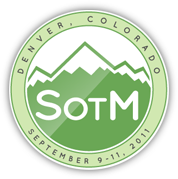GIS-based calibration of MassMov2D
Session Type:
Academic Session
Presenter(s):
Eng Monia Molinari, Institute of Earth Sciences - SUPSI
Dr Massimiliano Cannata
MassMov2D (Begueria et al., 2009) is a numerical model for simulating run-out and deposition of landslide phenomena over a complex topography; the software, based on Saint-Venant equations (Navier-Stokes equations under shallow water assumption) with the integration of rheological models for the flow behavior control, is implemented within the free GIS PCRaster and is distributed under an 'Attribution Non-Commercial Share Alike' license; currently the porting of the code into GRASS GIS with GPL license is under development.
During this research the model has been applied to the case study of the “Cè” instability: a complex landslide located on the left slope of the Canaria stream. In case of failure the mass accumulation would probably generate a natural dam that, if collapsing, would consequentially produce a flash flood. This may severely damage the population and the transport infrastructures (highway, main road and railway) of North-South axis of San Gottardo, with consequent high economic losses.
In agreement with the exposed scenario, a partial failure involving a volume of 350000 m3 happened in 2009: fortunately in this case the damages were limited. Thanks to a monitoring program performed with traditional survey techniques and terrestrial laser scanning, high resolution (1m) digital elevation model of the area before and after the collapse was available.
This research improved the MassMov2D code introducing the Nash-Sutcliffe model efficiency coefficient calculation in order to enable the semi-automatic sensitivity analysis and calibration that may replace the inefficient ‘trial and error’ approach that has been be used for this model.
Here the authors want to illustrate (i) the mathematical model foundations, (ii) the sensitivity and calibration process with the obtained results and (iii) the risk assessment analysis results. Moreover, the porting of the model to the GRASS GIS will be illustrated and presented.
It has to be noted that the risk analysis has been performed by applying the calibrated model to different future expected failures scenarios; all the analyses steps, with exception of the modeling, have been performed taking advantage of the GRASS GIS processing features.
References
Begueria S., Van Asch Th.W.J., Malet J.P., Gröndhal S., 2009: A GIS-based numerical model for simulating the kinematics of mud and debris flows over complex terrain. Natural Hazards and Earth System Sciences, Vol. 9, Number 6, 1897-1909.
Speaker Bio:
MA in Environmental Engineering at Politecnico di Milano; PhD student in Earth Sciences at University of Pavia
Schedule info
Time slot:
Thu, 09/15/2011 - 11:00am - 11:30am
Room:
Spruce 










